

Grammar


Tenses


Present

Present Simple

Present Continuous

Present Perfect

Present Perfect Continuous


Past

Past Continuous

Past Perfect

Past Perfect Continuous

Past Simple


Future

Future Simple

Future Continuous

Future Perfect

Future Perfect Continuous

Passive and Active


Parts Of Speech


Nouns

Countable and uncountable nouns

Verbal nouns

Singular and Plural nouns

Proper nouns

Nouns gender

Nouns definition

Concrete nouns

Abstract nouns

Common nouns

Collective nouns

Definition Of Nouns


Verbs

Stative and dynamic verbs

Finite and nonfinite verbs

To be verbs

Transitive and intransitive verbs

Auxiliary verbs

Modal verbs

Regular and irregular verbs

Action verbs


Adverbs

Relative adverbs

Interrogative adverbs

Adverbs of time

Adverbs of place

Adverbs of reason

Adverbs of quantity

Adverbs of manner

Adverbs of frequency

Adverbs of affirmation


Adjectives

Quantitative adjective

Proper adjective

Possessive adjective

Numeral adjective

Interrogative adjective

Distributive adjective

Descriptive adjective

Demonstrative adjective


Pronouns

Subject pronoun

Relative pronoun

Reflexive pronoun

Reciprocal pronoun

Possessive pronoun

Personal pronoun

Interrogative pronoun

Indefinite pronoun

Emphatic pronoun

Distributive pronoun

Demonstrative pronoun


Pre Position


Preposition by function

Time preposition

Reason preposition

Possession preposition

Place preposition

Phrases preposition

Origin preposition

Measure preposition

Direction preposition

Contrast preposition

Agent preposition


Preposition by construction

Simple preposition

Phrase preposition

Double preposition

Compound preposition


Conjunctions

Subordinating conjunction

Correlative conjunction

Coordinating conjunction

Conjunctive adverbs


Interjections

Express calling interjection


Grammar Rules

Preference

Requests and offers

wishes

Be used to

Some and any

Could have done

Describing people

Giving advices

Possession

Comparative and superlative

Giving Reason

Making Suggestions

Apologizing

Forming questions

Since and for

Directions

Obligation

Adverbials

invitation

Articles

Imaginary condition

Zero conditional

First conditional

Second conditional

Third conditional

Reported speech


Linguistics

Phonetics

Phonology


Semantics


Pragmatics

Linguistics fields

Syntax

Morphology

Semantics

pragmatics

History

Writing

Grammar

Phonetics and Phonology


Reading Comprehension

Elementary

Intermediate

Advanced
What is Ezafe? (Samiian 1994)
المؤلف:
RICHARD LARSON AND HIROKO YAMAKIDO
المصدر:
Adjectives and Adverbs: Syntax, Semantics, and Discourse
الجزء والصفحة:
p45-c3
2025-04-05
45
What is Ezafe? (Samiian 1994)
The presence of the Ezafe “linking” morpheme raises a simple and very natural question. What is Ezafe? What function does Ezafe serve in the grammar of Persian and languages like it? In an interesting article, Vida Samiian (1994) argues that Farsi Ezafe is a case marker, inserted before complements of [+N] categories, including Ns, As, and some Ps. Samiian supports this claim by observing that the use of Ezafe extends considerably beyond modification. Many contexts where English would use the (genitive) case-marking preposition of are ones in which Ezafe occurs, including complements of N (1a–c), complements of A (2a–c), and certain partitive constructions (3a, b).
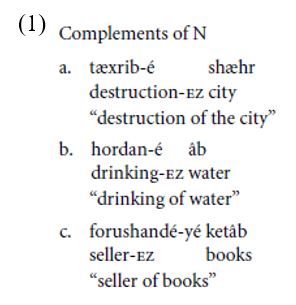
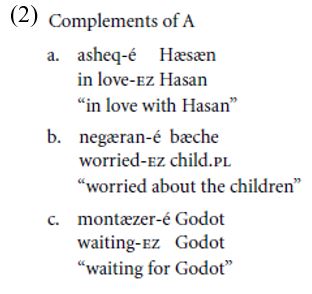
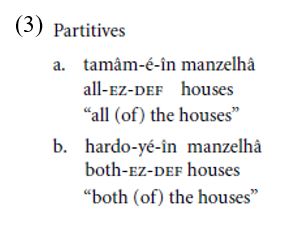
The role played by of in the counterpart English cases is to case-mark the complement following adjectives, nouns, and partitives. Samiian suggests that Ezafe plays the same role here.
Perhaps the most persuasive piece of evidence Samiian gives is the behavior of the category P, which initially looks like a problem for Samiian’s proposal. Since prepositions are typically analyzed as [−N,−V] elements, PP would not be expected to require Ezafe marking; furthermore, P would not be expected to require Ezafe to case-license its object, contrary to what we observed in (1b)/(3e). However, Samiian shows that the class of prepositions in Farsi is not uniform with respect to Ezafe. As shown in (4), some prepositions reject Ezafe (call these Class 1). By contrast, as shown in (5) and (6), other prepositions either permit Ezafe, or require it (call these Class 2):
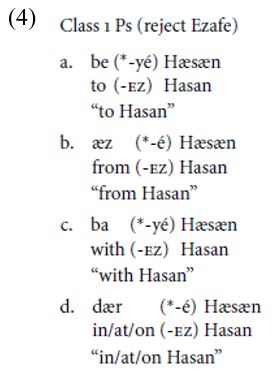
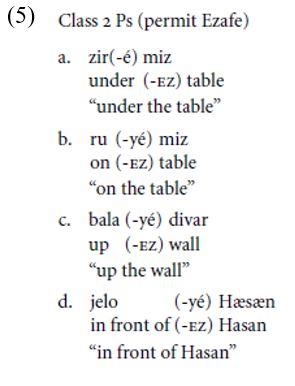
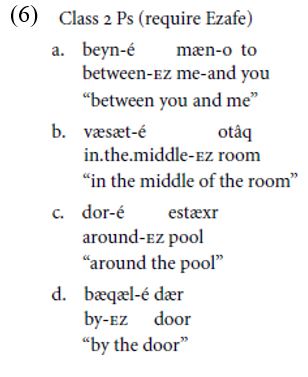
Samiian shows that whereas Class 1 prepositions are true function words equivalent to English Ps, Class 2 prepositions are really noun-like elements. For example, Class 1 prepositions require an object, whereas Class 2 Ps do not (7a, b). Class 2 Ps can occur after determiners and can even bear plural morphology (whose function is apparently intensification) (7c, d), whereas Class 1 prepositions cannot. Finally, only PPs headed by Class 2 prepositions appear in case positions and are joined to nominals by Ezafe; Class 1 prepositions do not (7e, f).
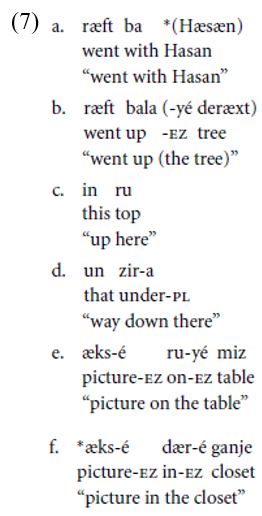
The upshot is that, instead of being a counterexample to the case marker hypothesis, Farsi PPs appear to provide further support for it. It is exactly the noun-like (and presumably [+N]) prepositions that trigger the Ezafe phenomenon – exactly the prepositions that would not be expected to assign case, and whose projections would require it. As a point of comparison with English, we might note that Class 2 prepositions in Farsi appear to resemble complex English Ps like (8a, b), which contain an internal nominal element (cause, spite) and require an internal genitive case-assigner (of).

We find Samiian’s analysis of Ezafe convincing; however, if the analysis is correct, important additional questions arise. Accepting that Ezafe occurs to case-mark complements of non-verbal elements, how do modifiers fit in? For example, even if adjectives, as [+N] categories, are case-bearing elements, why would modifiers need case?